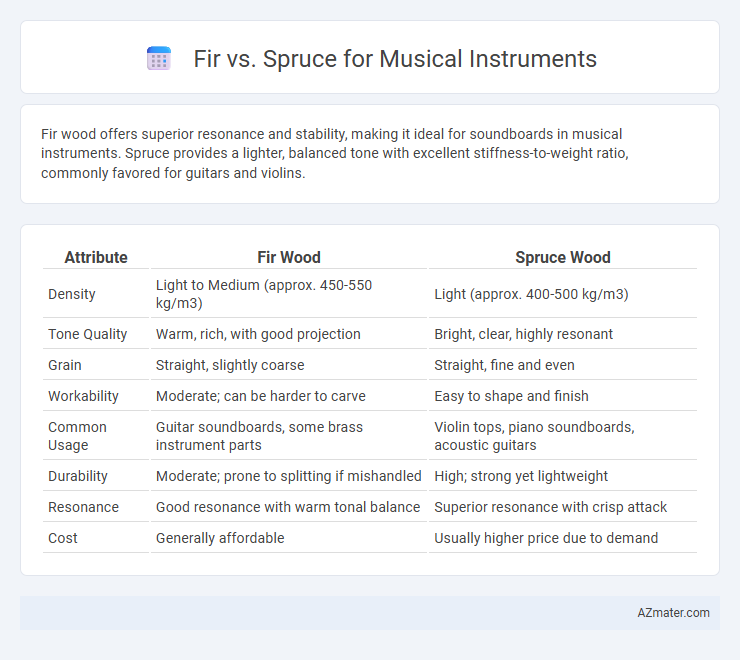Fir wood offers superior resonance and stability, making it ideal for soundboards in musical instruments. Spruce provides a lighter, balanced tone with excellent stiffness-to-weight ratio, commonly favored for guitars and violins.
Table of Comparison
| Attribute | Fir Wood | Spruce Wood |
|---|---|---|
| Density | Light to Medium (approx. 450-550 kg/m3) | Light (approx. 400-500 kg/m3) |
| Tone Quality | Warm, rich, with good projection | Bright, clear, highly resonant |
| Grain | Straight, slightly coarse | Straight, fine and even |
| Workability | Moderate; can be harder to carve | Easy to shape and finish |
| Common Usage | Guitar soundboards, some brass instrument parts | Violin tops, piano soundboards, acoustic guitars |
| Durability | Moderate; prone to splitting if mishandled | High; strong yet lightweight |
| Resonance | Good resonance with warm tonal balance | Superior resonance with crisp attack |
| Cost | Generally affordable | Usually higher price due to demand |
Introduction to Fir and Spruce in Musical Instruments
Spruce is the preferred wood for musical instrument soundboards due to its exceptional strength-to-weight ratio and resonant qualities, which enhance sound projection and clarity. Fir, while less common, offers a similar lightweight structure but with a slightly softer tone, making it suitable for niche applications in instrument crafting. Both woods contribute unique acoustic properties that influence the tonal character and responsiveness of stringed instruments like guitars and violins.
Botanical Differences: Fir vs Spruce
Fir (Abies spp.) features flat, soft needles and smooth, resinous bark, while Spruce (Picea spp.) has sharp, square needles and scaly bark, highlighting key botanical differences. Fir wood tends to have a finer, less pronounced grain compared to Spruce's distinct straight grain, which affects resonance in musical instruments. Spruce is often preferred for soundboards due to its combination of strength and elasticity, whereas fir's unique cellular structure offers different tonal qualities but is less commonly used in high-end instruments.
Acoustic Properties Comparison
Fir and spruce both offer distinct acoustic properties essential for musical instruments; spruce is favored for its superior stiffness-to-weight ratio, providing bright, clear tones with excellent resonance and projection. Fir produces a warmer, more balanced sound due to its denser grain and slightly softer stiffness, contributing to a mellower tonal quality ideal for certain string instruments. Spruce's consistency in grain structure makes it the preferred choice for high-end acoustic guitars and violins where dynamic responsiveness and sustain are critical.
Tone Quality: Fir vs Spruce Sound
Fir and spruce are both popular tonewoods used in musical instruments, particularly guitars and violins, prized for their sound qualities. Spruce, especially Sitka and Engelmann varieties, is renowned for its bright, clear, and resonant tone with excellent dynamic range, making it a standard choice for many acoustic instruments. Fir offers a warmer, softer sound with less brightness but strong midrange emphasis, making it suitable for musicians seeking a mellower, more balanced tonal character.
Workability and Luthier Preferences
Fir offers excellent workability with its softer grain, making it easier for luthiers to carve intricate details and achieve fine tuning on musical instruments. Spruce is highly favored for its strength-to-weight ratio and consistent grain structure, providing superior resonance and stability favored in high-quality acoustic instruments. Many luthiers prefer spruce for soundboards due to its optimal balance of durability and tonal clarity, while fir is occasionally chosen for less demanding components or experimental builds.
Durability and Longevity in Instruments
Fir offers moderate durability and is less commonly used in musical instruments due to its softness and tendency to dent, which can affect the instrument's longevity. Spruce, especially Sitka spruce, is renowned for its exceptional strength-to-weight ratio, providing both durability and long-lasting performance in soundboards and other critical components. Instruments crafted with spruce typically maintain structural integrity and tonal quality over time, making spruce a preferred choice for long-lasting musical instruments.
Cost and Availability of Fir and Spruce
Spruce is the most popular tonewood for musical instruments due to its superior resonance and availability, commonly sourced from regions like the Pacific Northwest and the Alps, but it tends to be more expensive than fir. Fir, while less commonly used, offers a more affordable alternative with decent tonal qualities, often harvested from easily accessible North American forests, making it a budget-friendly choice for beginners or experimental luthiers. The cost difference between spruce and fir mainly reflects spruce's higher demand and sound performance, whereas fir's accessibility translates to better availability at lower prices.
Popular Instruments Made from Fir
Fir is widely used in the construction of acoustic guitars and violins due to its lightweight and resonant properties, which enhance sound clarity and projection. Popular models such as certain classical guitars and ukuleles often feature fir tops to achieve a warm, balanced tone with strong midrange presence. Compared to spruce, fir offers a distinct timbre favored by musicians seeking a softer attack and richer harmonic overtones in their instruments.
Popular Instruments Made from Spruce
Spruce is the preferred wood for soundboards in popular musical instruments such as acoustic guitars, violins, and pianos due to its excellent strength-to-weight ratio and superior resonance. Its tight grain structure allows for clear, bright tones, making it ideal for string instruments that require dynamic sound projection. Fir is less commonly used in instrument making because it lacks the consistent tonal qualities and stiffness that spruce provides.
Choosing the Right Wood for Your Musical Instrument
Fir wood offers moderate resonance and durability, suitable for budget-friendly musical instruments but lacks the bright tonal clarity of spruce. Spruce is highly favored in instrument making for its exceptional stiffness-to-weight ratio, producing superior sound projection and rich harmonic overtones crucial for guitars, violins, and pianos. Selecting spruce over fir ensures enhanced acoustic performance and longevity, making it the optimal choice for professional-grade musical instruments.

Infographic: Fir vs Spruce for Musical Instrument
 azmater.com
azmater.com